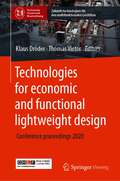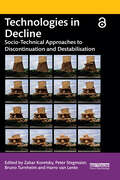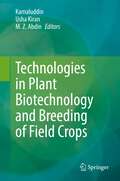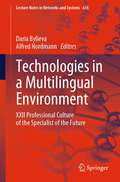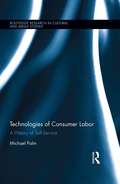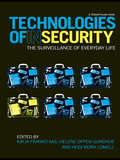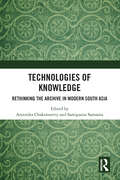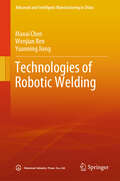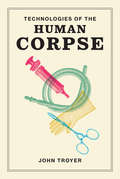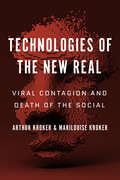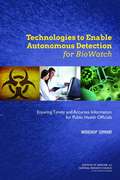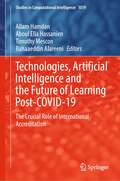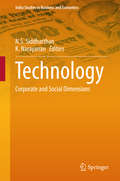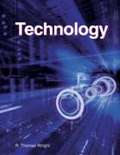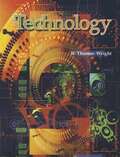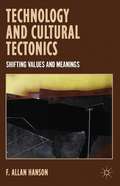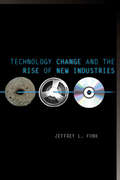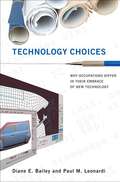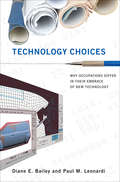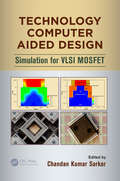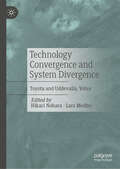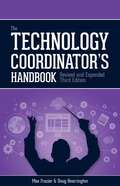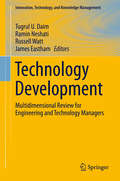- Table View
- List View
Technologies for economic and functional lightweight design: Conference proceedings 2020 (Zukunftstechnologien für den multifunktionalen Leichtbau)
by Thomas Vietor Klaus DröderThis book comprises the proceedings of the conference “Future Production of Hybrid Structures 2020”, which took place in Wolfsburg.The conference focused on hybrid lightweight design, which is characterized by the combination of different materials with the aim of improving properties and reducing weight. In particular, production technologies for hybrid lightweight design were discussed, new evaluation methods for the ecological assessment of hybrid components were presented and future-oriented approaches motivated by nature for the development of components, assemblies and systems were introduced.Lightweight design is a key technology for the development of sustainable and resource-efficient mobility concepts. Vehicle manufacturers operate in an area of conflict between customer requirements, competition and legislation. Material hybrid structures, which combine the advantages of different materials, have a high potential for reducing weight, while simultaneously expanding component functionality. The future, efficient use of function-integrated hybrid structures in vehicle design requires innovations and constant developments in vehicle and production technology. There is a great demand, especially with regard to new methods and technologies, for "affordable" lightweight construction in large-scale production, taking into account the increasing requirements with regard to variant diversity, safety and quality.
Technologies in Decline: Socio-Technical Approaches to Discontinuation and Destabilisation
by Harro Van Lente Bruno Turnheim Peter Stegmaier Zahar KoretskyThe central questions of this book are how technologies decline, how societies deal with technologies in decline, and how governance may be explicitly oriented towards parting with ‘undesirable’ technology. Surprisingly, these questions are fairly novel. Thus far, the dominant interest in historical, economic, sociological and political studies of technology has been to understand how novelty emerges, how innovation can open up new opportunities and how such processes may be supported. This innovation bias reflects how in the last centuries modern societies have embraced technology as a vehicle of progress. It is timely, however, to broaden the social study of technology and society: next to considering the rise of technologies, their fall should be addressed, too. Dealing with technologies in decline is an important challenge or our times, as socio-technical systems are increasingly part of the problems of climate change, biodiversity loss, social inequalities and geo-political tensions. This volume presents empirical studies of technologies in decline, as well as conceptual clarifications and theoretical deepening. Technologies in Decline presents an emerging research agenda for the study of technological decline, emphasising the need for a plurality of perspectives. Given that destabilisation and discontinuation are seen as a way to accelerate sustainability transitions, this book will be of interest to academics, students and policy makers researching and working in the areas of sustainability science and policy, economic geography, innovation studies, and science and technology studies.
Technologies in Plant Biotechnology and Breeding of Field Crops
by M. Z. Abdin Usha Kiran KamaluddinThis edited book is a comprehensive compilation of principles, conventional and molecular approaches used to develop improved varieties and hybrids of major crops in light of their origin, evolution, taxonomy, production and productivity and need by human civilization. The book covers breeding prospects of all important food and commercial crops. It highlights the importance of breeding tools and techniques in ensuring food security. This book is of interest to teachers, researchers, agriculture scientists, capacity builders, and policymakers. Also, the book serves as additional reading material for undergraduate and graduate students of agriculture, soil science, and environmental sciences. National and international agricultural scientists and policymakers will find this book useful.
Technologies in a Multilingual Environment: XXII Professional Culture of the Specialist of the Future (Lecture Notes in Networks and Systems #636)
by Alfred Nordmann Daria BylievaThe book addresses the challenge of living in a multilingual world from three perspectives: socio-linguistics and the study of multilingualism in contrast, philosophy of technology with its emphasis on the world as a technosphere—how it is made, how it is experienced, and how it can be managed, and then pedagogy and the question of teaching and learning to competently negotiate multilingual environments. In today‘s multicultural and multilingual world, technologies provide a common ground. The story of the technosphere as a multilingual environment offers new perspective, namely that of learning to cooperate and coordinate.
Technologies of Consumer Labor: A History of Self-Service (Routledge Research in Cultural and Media Studies)
by Michael PalmThis book documents and examines the history of technology used by consumers to serve oneself. The telephone’s development as a self-service technology functions as the narrative spine, beginning with the advent of rotary dialing eliminating most operator services and transforming every local connection into an instance of self-service. Today, nearly a century later, consumers manipulate 0-9 keypads on a plethora of digital machines. Throughout the book Palm employs a combination of historical, political-economic and cultural analysis to describe how the telephone keypad was absorbed into business models across media, retail and financial industries, as the interface on everyday machines including the ATM, cell phone and debit card reader. He argues that the naturalization of self-service telephony shaped consumers’ attitudes and expectations about digital technology.
Technologies of InSecurity: The Surveillance of Everyday Life
by Katja Aas Helene Gundhus Heidi LomellTechnologies of Insecurity examines how general social and political concerns about terrorism, crime, migration and globalization are translated into concrete practices of securitisation of everyday life. Who are we afraid of in a globalizing world? How are issues of safety and security constructed and addressed by various local actors and embodied in a variety of surveillance systems? Examining how various forms of contemporary insecurity are translated into, and reduced to, issues of surveillance and social control, this book explores a variety of practical and cultural aspects of technological control, as well as the discourses about safety and security surrounding them. (In)security is a politically and socially constructed phenomenon, with a variety of meanings and modalities. And, exploring the inherent duality and dialectics between our striving for security and the simultaneous production of insecurity, Technologies of Insecurity considers how mundane objects and activities are becoming bearers of risks which need to be neutralised. As ordinary arenas - such as the workplace, the city centre, the football stadium, the airport, and the internet - are imbued with various notions of risk and danger and subject to changing public attitudes and sensibilities, the critical deconstruction of the nexus between everyday surveillance and (in)security pursued here provides important new insights about how broader political issues are translated into concrete and local practices of social control and exclusion.
Technologies of Knowledge: Rethinking the Archive in Modern South Asia
by Samiparna Samanta Aryendra ChakravarttyThis book traces the role of technology in shaping, curating, disseminating, and archiving knowledge and life in South Asia. It focuses on empirical studies of transformative social processes unleashed by technological intervention in colonial and postcolonial contexts, which have changed our everyday lives and created new sites of domination and resistance, and new archives of history.Unraveling technology as an indicator of South Asia’s encounter with modernity, the chapters in the volume interrogate how technology was witnessed in the production of culture, historicizing and preserving the past, and establishing claims to heritage and history. In addition to examining the critical role of creative and commercial networks in establishing communities, the volume also scans the significant contribution of technology as a mechanism of social control. It highlights the pervasive nature of discourse that continues to assert its legitimacy, despite significant challenges to its structures of dominance, be it in the case of Bengali women or imperial dreams of curating a rapidly eroding past. In doing so, the volume emphasizes the discursive thoughts and practices that permeate the functioning of an empire and a postcolonial nation-state through narratives of resilience, appropriation, silences, and dissent.This volume will be of great interest to scholars and researchers of science and technology studies, digital humanities, South Asian studies, modern history, colonialism, and post-independence India.
Technologies of Robotic Welding (Advanced and Intelligent Manufacturing in China)
by Maoai Chen Wenjian Ren Yuanning JiangThe book deals with robotic welding systems and their applications. The mechanical design of manipulator, sensing technology, welding process, manipulating technology, and maintenance procedure of welding robot are presented in detail, with must-know basic theories about operation principle of robot briefly introduced. The book features a large quantity of carefully selected images and tables to help the reader understand the technologies of robotic welding easily and quickly. The book benefits welding engineers, mechanical engineers, researchers, and senior undergraduate students and postgraduate students in the fields of welding engineering, mechanical engineering, etc.
Technologies of the Human Corpse (The\mit Press Ser.)
by John TroyerThe relationship of the dead body with technology through history, from nineteenth-century embalming machines to the death-prevention technologies of today.Death and the dead body have never been more alive in the public imagination—not least because of current debates over modern medical technology that is deployed, it seems, expressly to keep human bodies from dying, blurring the boundary between alive and dead. In this book, John Troyer examines the relationship of the dead body with technology, both material and conceptual: the physical machines, political concepts, and sovereign institutions that humans use to classify, organize, repurpose, and transform the human corpse. Doing so, he asks readers to think about death, dying, and dead bodies in radically different ways. Troyer explains, for example, how technologies of the nineteenth century including embalming and photography, created our image of a dead body as quasi-atemporal, existing outside biological limits formerly enforced by decomposition. He describes the “Happy Death Movement” of the 1970s; the politics of HIV/AIDS corpse and the productive potential of the dead body; the provocations of the Body Worlds exhibits and their use of preserved dead bodies; the black market in human body parts; and the transformation of historic technologies of the human corpse into “death prevention technologies.” The consequences of total control over death and the dead body, Troyer argues, are not liberation but the abandonment of Homo sapiens as a concept and a species. In this unique work, Troyer forces us to consider the increasing overlap between politics, dying, and the dead body in both general and specifically personal terms.
Technologies of the New Real: Viral Contagion and Death of the Social (Digital Futures)
by Arthur Kroker Marilouise KrokerWith astonishing speed, we have been projected into a new reality where interactions with drones, robotic bodies, and high-level surveillance are increasingly mainstream. In this age of groundbreaking developments in robotic technologies, synthetic biology is merging with artificial intelligence, forming a newly blended reality of machines, bodies, and affect. Technologies of the New Real draws from critical intersections of technology and society – including drones, surveillance, DIY bodies, and innovations in robotic technology – to explore what these advances can tell us about our present reality, or what authors Arthur and Marilouise Kroker deem the "new real" of digital culture in the twenty-first century. Technologies of the New Real explores the many technologies of our present reality as they infiltrate the social, political, and economic static of our everyday lives, seemingly eroding traditionally conceived boundaries between humans and machines, and rendering fully ambivalent borders between the human mind and simulated data.
Technologies to Enable Autonomous Detection for BioWatch
by Institute of Medicine National Research Council Board on Health Sciences Policy Board on Life Sciences Joe Alper Sheena M. Posey Norris India Hook-BarnardThe BioWatch program, funded and overseen by the Department of Homeland Security (DHS), has three main elements--sampling, analysis, and response--each coordinated by different agencies. The Environmental Protection Agency maintains the sampling component, the sensors that collect airborne particles. The Centers for Disease Control and Prevention coordinates analysis and laboratory testing of the samples, though testing is actually carried out in state and local public health laboratories. Local jurisdictions are responsible for the public health response to positive findings. The Federal Bureau of Investigation is designated as the lead agency for the law enforcement response if a bioterrorism event is detected. In 2003 DHS deployed the first generation of BioWatch air samplers. The current version of this technology, referred to as Generation 2.0, requires daily manual collection and testing of air filters from each monitor. DHS has also considered newer automated technologies (Generation 2.5 and Generation 3.0) which have the potential to produce results more quickly, at a lower cost, and for a greater number of threat agents. Technologies to Enable Autonomous Detection for BioWatch is the summary of a workshop hosted jointly by the Institute of Medicine and the National Research Council in June 2013 to explore alternative cost-effective systems that would meet the requirements for a BioWatch Generation 3.0 autonomous detection system, or autonomous detector, for aerosolized agents . The workshop discussions and presentations focused on examination of the use of four classes of technologies--nucleic acid signatures, protein signatures, genomic sequencing, and mass spectrometry--that could reach Technology Readiness Level (TRL) 6-plus in which the technology has been validated and is ready to be tested in a relevant environment over three different tiers of temporal timeframes: those technologies that could be TRL 6-plus ready as part of an integrated system by 2016, those that are likely to be ready in the period 2016 to 2020, and those are not likely to be ready until after 2020. Technologies to Enable Autonomous Detection for BioWatch discusses the history of the BioWatch program, the role of public health officials and laboratorians in the interpretation of BioWatch data and the information that is needed from a system for effective decision making, and the current state of the art of four families of technology for the BioWatch program. This report explores how the technologies discussed might be strategically combined or deployed to optimize their contributions to an effective environmental detection capability.
Technologies, Artificial Intelligence and the Future of Learning Post-COVID-19: The Crucial Role of International Accreditation (Studies in Computational Intelligence #1019)
by Aboul Ella Hassanien Timothy Mescon Allam Hamdan Bahaaeddin AlareeniThis book aims to assess the experience of education during COVID-19 pandemic and explore the future of application of technologies and artificial intelligence in education. Education delivery requires the support of new technologies such as artificial intelligence (AI), the Internet of Things (IoT), big data, and machine learning to fight and aspire to new diseases. The academic community and those interested in education agree that education after the corona pandemic will not be the same as before. The book also questions the role of accreditation bodies (e.g., AACSB, etc.) to ensure the effectiveness and efficiency of technology tools in achieving distinguished education in times of crisis.
Technology
by Brad Thode Terry ThodeThis book, Technology, is designed to help people apply technology in the solution of major problems that face society. While complete in itself, the text is enhanced with technology such as bar-code-driven laserdiscs, computer software to support design brief activities, and videotapes. It is a book about technology to be used with technology to produce a dynamic learning experience for the student.
Technology
by K. Narayanan N. S. SiddharthanThis volume deals with the role and impact of technology on the economy and society. The papers on corporate dimensions address the impact of patents, determinants of innovative activities, differential behaviour of multinationals, industrial groups and other firms with regard to innovations and technology. In contrast, the papers on social dimensions chiefly deal with the role of technology in reducing inequality. The majority of the papers employ econometric techniques and other statistical methods, and many are based on primary data. The studies emphasise the importance of innovations (especially patents) and human capital in influencing productivity across Indian states, the significance of patenting in determining the efficiency of firms, the role of business groups in promoting innovations, differences in the technological characteristics of multinational and domestic firms, and how mergers and acquisitions can promote R&D. The papers on social dimensions analyse how innovative activities can shape employment, the impact of technology on poverty, the socioeconomic characteristics of mobile phone ownerships, use of information and communications technologies at educational institutions, and the influence of Synchronous Technologies in reducing access to teaching programmes. The studies show that those Indian states that have invested in human capital and technology experienced higher labour productivity. Further, the studies establish a positive correlation between R&D spending and employment. Lastly, they demonstrate that the adoption of agriculture-related technologies can have a significant impact on rural poverty and consumption expenditures.
Technology
by R. Thomas WrightThe book helps students realize how technology affects people and the world in which we live.
Technology
by R. Thomas WrightThe latest edition of Technology will help students realize how technology affects people and the world in which we live. Numerous illustrations and easy-to-read text enable understanding of how people use technology and why technological systems work the way they do. Student-friendly features, such as Tomorrow s Technology Today, Technology Explained, Connections to Technology, and Career Corners, provide numerous practical examples of the impacts of technology on our world. This edition of the book has a broadened scope, with information on automation and robotics, digital photography, digital signals, and job skills and employment. The book is fully correlated to the Standards for Technological Literacy.
Technology And Cultural Tectonics
by F. Allan HansonWhat impact has technology had on cultural meanings, values, and symbols? This anthropological exploration shows how technologies produce novel and sometimes jarring realignments among cultural institutions.
Technology Applications in Education: A Learning View
by Ray S. Perez Harold F. O'NeilThis volume identifies promising learning, teaching, and assessment strategies for the use and assessment of technology in educational settings, specifically: *educational context (e.g., organizational and structural factors that contribute to the effective use of technology in school settings); *promising learning and teaching strategies; *promising technology-based assessment procedures and methods; *policy implementation issues; and *a summary of current research on the effective use of technology in education. Chapter authors represent a variety of perspectives and disciplines, from computer science, cognitive and educational psychology, and educational administration. Authors represent government, business, and university communities from within and outside the U.S. These multiple perspectives contribute to the overall understanding of current technology use in education and help in identifying future research needs. Technology Applications in Education: A Learning View explores the state of the art of technology in K-16 education from a learning perspective rather than a hardware/software view. It is designed for professionals and graduate students in the educational technology, training, assessment/evaluation, school administration, military psychology, and educational psychology communities. This book is characterized in the following montage of factors: *the primacy of learning as a focus for technology implementation; *a focus on technology uses in K-16 education; *a focus on the assessment of both individuals and teams; *a broad variety of methodological approaches from qualitative to instructional design to quantitative (e.g., structural equation modeling); *a need to support the development of technology-based curriculum and tools; and *a need for theory-driven and evaluation studies to increase our knowledge.
Technology Change and the Rise of New Industries
by Jeffrey L. FunkTechnology Change and the Rise of New Industries explores why new industries emerge at specific moments in time and in certain countries. Part I shows that technologies which experience "exponential" improvements in cost and performance have a greater chance of becoming new industries. When "low-end" discontinuities incur exponential improvements, they often displace the dominant technologies and become "disruptive" innovations. Part II explores this phenomenon and instances in which discontinuities spawn new industries because they impact higher-level systems. Part III addresses a different set of questions—ones that consider the challenges of new industries for firms and governments. Part IV uses ideas from the previous chapters to analyze the present and future of selected technologies. Based on analyses of many industries, including those with an electronic and clean energy focus, this book challenges the conventional wisdom that performance dramatically rises following the emergence of a new technology, that costs fall due to increases in cumulative production, and that low-end innovations automatically become disruptive ones.
Technology Choices
by Diane E. Bailey Paul M. LeonardiWhy do people who perform largely the same type of work make different technology choices in the workplace? An automotive design engineer working in India, for example, finds advanced information and communication technologies essential, allowing him to work with far-flung colleagues; a structural engineer in California relies more on paper-based technologies for her everyday work; and a software engineer in Silicon Valley operates on multiple digital levels simultaneously all day, continuing after hours on a company-supplied home computer and network connection. In Technology Choices, Diane Bailey and Paul Leonardi argue that occupational factors -- rather than personal preference or purely technological concerns -- strongly shape workers' technology choices. Drawing on extensive field work -- a decade's worth of observations and interviews in seven engineering firms in eight countries -- Bailey and Leonardi challenge the traditional views of technology choices: technological determinism and social constructivism. Their innovative occupational perspective allows them to explore how external forces shape ideas, beliefs, and norms in ways that steer individuals to particular technology choices -- albeit in somewhat predictable and generalizable ways. They examine three relationships at the heart of technology choices: human to technology, technology to technology, and human to human. An occupational perspective, they argue, helps us not only to understand past technology choices, but also to predict future ones.
Technology Choices: Why Occupations Differ in Their Embrace of New Technology (Acting with Technology)
by Diane E. Bailey Paul M. LeonardiAn analysis of the occupational factors that shape the technology choices made by people who perform the same type of work. Why do people who perform largely the same type of work make different technology choices in the workplace? An automotive design engineer working in India, for example, finds advanced information and communication technologies essential, allowing him to work with far-flung colleagues; a structural engineer in California relies more on paper-based technologies for her everyday work; and a software engineer in Silicon Valley operates on multiple digital levels simultaneously all day, continuing after hours on a company-supplied home computer and network connection. In Technology Choices, Diane Bailey and Paul Leonardi argue that occupational factors—rather than personal preference or purely technological concerns—strongly shape workers' technology choices. Drawing on extensive field work—a decade's worth of observations and interviews in seven engineering firms in eight countries—Bailey and Leonardi challenge the traditional views of technology choices: technological determinism and social constructivism. Their innovative occupational perspective allows them to explore how external forces shape ideas, beliefs, and norms in ways that steer individuals to particular technology choices—albeit in somewhat predictable and generalizable ways. They examine three relationships at the heart of technology choices: human to technology, technology to technology, and human to human. An occupational perspective, they argue, helps us not only to understand past technology choices, but also to predict future ones.
Technology Computer Aided Design: Simulation for VLSI MOSFET
by Chandan Kumar SarkarResponding to recent developments and a growing VLSI circuit manufacturing market, Technology Computer Aided Design: Simulation for VLSI MOSFET examines advanced MOSFET processes and devices through TCAD numerical simulations. The book provides a balanced summary of TCAD and MOSFET basic concepts, equations, physics, and new technologies related to TCAD and MOSFET. A firm grasp of these concepts allows for the design of better models, thus streamlining the design process, saving time and money. This book places emphasis on the importance of modeling and simulations of VLSI MOS transistors and TCAD software. Providing background concepts involved in the TCAD simulation of MOSFET devices, it presents concepts in a simplified manner, frequently using comparisons to everyday-life experiences. The book then explains concepts in depth, with required mathematics and program code. This book also details the classical semiconductor physics for understanding the principle of operations for VLSI MOS transistors, illustrates recent developments in the area of MOSFET and other electronic devices, and analyzes the evolution of the role of modeling and simulation of MOSFET. It also provides exposure to the two most commercially popular TCAD simulation tools Silvaco and Sentaurus.• Emphasizes the need for TCAD simulation to be included within VLSI design flow for nano-scale integrated circuits• Introduces the advantages of TCAD simulations for device and process technology characterization• Presents the fundamental physics and mathematics incorporated in the TCAD tools• Includes popular commercial TCAD simulation tools (Silvaco and Sentaurus)• Provides characterization of performances of VLSI MOSFETs through TCAD tools • Offers familiarization to compact modeling for VLSI circuit simulationR&D cost and time for electronic product development is drastically reduced by taking advantage of TCAD tools, making it indispensable for modern VLSI device technologies. They provide a means to characterize the MOS transistors and improve the VLSI circuit simulation procedure. The comprehensive information and systematic approach to design, characterization, fabrication, and computation of VLSI MOS transistor through TCAD tools presented in this book provides a thorough foundation for the development of models that simplify the design verification process and make it cost effective.
Technology Convergence and System Divergence: Toyota and Uddevalla, Volvo
by Hikari Nohara Lars MedboThis book compares the production systems of Toyota, which has a belt conveyer, and Volvo’s factory in Uddevalla, Sweden, which doesn’t. Uddevalla has been famous as a human-centric work environment since the 1980s, but Toyota’s production style- lean production seems increasingly advantageous. Unlike what lean production is usually considered to imply, the authors finds many shared aspects of both systems, such as the meaningful assembly sequence, assembly-oriented parts grouping, kits for material supplies, buffer mechanisms, and the application of cognitive science. However, in their totality, the different production systems have different impacts on people and society. The differences come from different ways of judging human potential. In this regard, Uddevalla and Toyota can be productively contrasted, identifying the comparative advantages of automation and human labor.
Technology Coordinator's Handbook, 3rd Edition
by Max Frasier Doug HearringtonThis handbook is designed to help technology coordinators become more effective learners and leaders so they can better assist students, teachers and administrators in the use of tech devices and resources. The technology coordinator can be seen as the orchestrator in the school or district, able to balance technology policies and procedures with device-specific requirements, locate funding and support, and facilitate ongoing training and support. In a time when technology is constantly changing, the technology coordinator adapts and stays abreast of the latest developments.This handbook is designed to help technology coordinators become more effective learners and leaders so they can better assist students, teachers and administrators in the use of tech devices and resources. The technology coordinator can be seen as the orchestrator in the school or district, able to balance technology policies and procedures with device-specific requirements, locate funding and support, and facilitate ongoing training and support. In a time when technology is constantly changing, the technology coordinator adapts and stays abreast of the latest developments. In this new edition of the highly respected Technology Coordinator’s Handbook, Max Frazier and co-author Doug Hearrington expand the scope of this practical guide to include New processes for technical support and technology lifecycle management. Considerations for BYOD programs. Practical advice on the implementation of cloud computing services. Profiles and job descriptions of technology coordinators and district leaders. Readers of this book — whether they are technology coordinators, teacher educators or administrators — will come away with a 360-degree view of the technology coordinator’s role and a new appreciation for teaching and learning with technology.
Technology Development
by Tugrul U. Daim Ramin Neshati Russell Watt James EasthamDeveloping new products, services, systems and processes has become an imperative for any firm expecting to thrive in today's fast-paced and hyper-competitive environment This volume integrates academic and practical insights to present fresh perspectives on new product development and innovation, showcasing lessons learned on the technological frontier The first part emphasizes decision making. The second part focuses on technology evaluation, including cost-benefit analysis, material selection and scenarios. The third part features in-depth case studies to present innovation management tools, such as customer needs identification, technology standardization and risk management. The fourth part highlights important international trends, such as globalization and outsourcing. Finally the fifth part explores social and political aspects.
